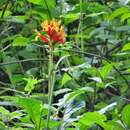Comprehensive Description
(
anglais
)
fourni par Smithsonian Contributions to Botany
Aphelandra lyrata Nees
Aphelandra lyrata Nees in de Candolle, Prodr. 11:302. 1847.—Leonard, Contrib. U.S. Nat. Herb. 31:150. 1953.
Aphelandra lyrata Nees var. latibractea Nees in de Candolle, Prodr. 11:302. 1847.
Aphelandra lyrata Nees var. laxior Nees in de Candolle, Prodr. 11:303. 1847.
Aphelandra lyrata Nees var. arguta Nees in de Candolle, Prodr. 11:303. 1847.
Aphelandra cajatambensis, Lindau, Bull. Herb. Boiss. ser. 2, 5:368. 1905.
Herb to 0.5 m high; stem erect, angled, often purple, sparingly pilose; leaf blades oblongobovate in outline, to 30 cm long and 9 cm wide, obtuse to acute, lyrate-pinnatifid, divided into 5 or 6 lobes, those at and below middle largest, oblong, about 4 cm long and 2 cm wide, becoming smaller toward tip and base, the sinuses rounded or obtuse, becoming larger and broader toward base (lowest 2 cm broad) the margins angulatedentate, the teeth mucronate, unarmed, both surfaces laxly pilose; petioles about 1 cm long; flowers borne in a terminal, solitary, peduncled spike, to 13 cm long, more or less lax, the peduncle to 9 cm long, both peduncle and rachis sparingly pilose; bracts lance-subulate to oblong, 10–12 mm long and about 4 mm wide, becoming smaller toward tip of spike, relatively thin, acute or acuminate, sparingly pilosulous, ciliate, the marginal hairs to 1 mm long, the lowermost serrate-dentate (3 teeth to 1.5 mm long on each side) the upper bearing 1 or 2 teeth or the uppermost entire; bractlets linearlanceolate, 10 mm long, 1 mm wide, sparingly puberulent, the margins pilose, entire, sometimes bearing one or two minute teeth; calyx segments lanceolate, ciliate, the posterior segment 10–11 mm long, about 4 mm wide, deeply cleft sometimes nearly to base, the teeth acuminate sometimes 2-toothed at tip, the other segments 9–10 mm long, 2–3.5 mm wide; corolla 3.5–4 cm long, scarlet or orange-red, the lobes yellow, glandular-pubescent, the tube nearly straight, about 3 cm long, 4 mm wide at base, narrowed slightly about 7 mm above base thence enlarged to 9 mm and again slightly narrowed at throat, the upper lip 10–11 mm long, 2-parted, the lobes rounded, the lower lip similar but slightly shorter; the longer pair of the stamens slightly exceeding the corolla; the filaments glabrous, anthers 3–3.5 mm long; pollen grains oblong, 61μ × 26μ.
TYPE.—McLean s.n. (holotype K), Peru, Lima, Canta, Canta.
DISTRIBUTION.—In Peru, from Cajamarca southward to Lima, at altitudes of 2300–2960 m. PERU. CAJAMARCA: Contumazá: Chausivolan, Guzmango, 2800 m alt, 1 Jun 1959, Sagástegui 2985 (HUT, US). AMAZONAS: Chachapoyas, Mathews s.n. (K). LA LIBERTAD: Otuzco: Llacmóm (Sinsicap), 2500 m alt, 16 Mar 1954, Vargas 0164 (CUZ, US). ANCASH: Cajatambo: Ocros, 2300–2400 m alt, Mar 1903, Weberbauer 2715 (F photo 8660, holotype of A. cajatambensis Lindau). LIMA: Lima, 1840, McLean s.n. (K); Cuesta de Puruchuco, Mathews 782 (K, holotype of A. lyrata var. laxior Nees); Canta: Between Canta and Yangas, 2300–2400 m alt, 16 Mar 1950, Ferreyra 6929 (US, USM); steep hillsides above Canta, 2960 m alt, 6 Mar 1960, Saunders 464 (K, US); Obrajillo, 1838–1942, Wilkes Expedition (G, NY, US). WITHOUT EXACT LOCALITY:Nuñez 4781 (US); “Colombia” probably Peru, Lobb s.n. (K, holotype of A. lyrata var. arguta Nees).
In his treatment of this species Nees cites the material examined under three varieties. His variety latibractea is based on a specimen collected at Canta, Peru, by McLean. The leaves are broad and subsessile, the peduncle longer, and the bracts all oval, mucronate, and closely toothed.
Variety laxior is based on a specimen collected at Cuesta de Puruchuco, Peru, by Mathews. The bracts in this form are described as oblong or oblong-spatulate and at least the lowermost closely dentate.
Variety arguta was collected in “Colombta,” probably Peru, by Lobb. Its bracts are oblong or linear-oblong, subspatulate, slightly obtuse, sparingly and obscurely toothed toward apex.
The author has examined these varieties deposited in the Hooker Herbarium and concludes from the descriptions and the additional material available that A. lyrata is just a variable species consisting of a number of races or forms.
- citation bibliographique
- Wasshausen, Dieter C. 1975. "The genus Aphelandra (Acanthaceae)." Smithsonian Contributions to Botany. 1-157. https://doi.org/10.5479/si.0081024X.18

